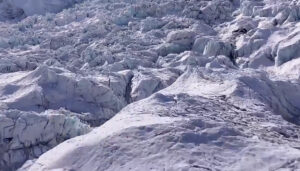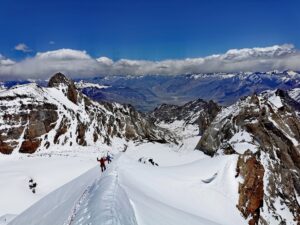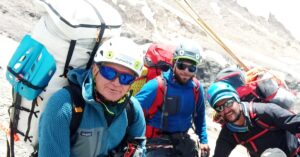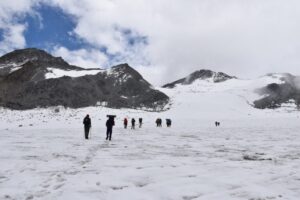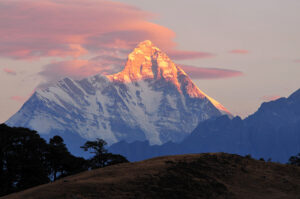This season, the first Everest summits came on May 14. The following day, the wind picked up and climbing conditions deteriorated. Descending on Lhotse, some climbers mentioned that they met Colombian Mateo Isaza on their way down. He wore only an air-warming mask and had just summited Everest without oxygen.
After his climb, Isaza simply went home. His climb was not promoted by the small outfitting company he had hired and there was no victory lap on social media. Even the team at The Himalayan Database didn’t know about him.
But Christian de Jong of the Netherlands, who climbed both Pumori and Nuptse this season without oxygen or support, knew Isaza and was not surprised.
“I climbed with him during the acclimatization phase. I totally believe he made it, that guy is super strong,” he told Billi Bierling of The Himalayan Database.
Below is a video of Isaza and De Jong near Camp 3 (De Jong is in the yellow suit).
This season, Isaza was the second (and final) climber to summit Everest without O2. We reached him at home in Medellin, Colombia. Surrounded by the mountains he grew up in, he was trying to process his Everest experience. It involved the joy of the summit but also a traumatic experience on the descent.
From the Andes to Everest
Isaza has been climbing for over 20 years, mainly in the Andes’ 6,000’ers. Here, he works as a mountain guide and runs an adventure travel agency, Sawa.
“Everest was always on my mind because my first mountain guide, Fernando Gonzalez, was the first Colombian to summit Everest and his love for the Himalaya enthralled me,” Isaza told us.
However, it was only four years ago that he seriously started preparing. The COVID pandemic forced him to abort his first trip to Nepal when the border closed just eight days before he was due to board the plane.
Isaza returned in 2021, and although bad weather stopped him at 7,500m, he felt strong without oxygen at that altitude. “It was my first Himalayan experience but I felt I could plan for a no-O2 ascent next time, without Sherpa support.”
“Going without oxygen was my personal goal and I was devoted to it. There is a long, thorough preparation behind my summit. Years of daily training, from gear to nutrition, to get the body prepared. Wanting it is not enough,” he explained.

Mateo Isaza. Photo: Sawa
Isaza hired a small outfitting company that (like many others in Nepal) outsourced their services to other outfitters with space in Base Camp. He hired Base Camp logistics, the right to use the fixed ropes, and food in Camp 2. He carried his gear, supplies, and tent up and down the mountain, making some deposits at altitude as he did his acclimatization rounds.
“I based my plan on what the guide from my 2021 expedition had told me and did two rounds,” Isaza said. “I wanted to get started as soon as possible, so at the start of the season, I went to Camp 1 and Camp 2 for five days despite very bad weather. The second rotation was straight to Camp 2, then a night in Camp 3, and a trip to the Geneva Spur [7,800m].”
High winds despite forecasts
Isaza intended to rest for four days, but a weather window opened unexpectedly. He ascended one day behind the rope-fixing team. On May 14, he reached Camp 4 and prepared to leave for the final push.
“The forecast said the winds would drop at 9 pm. People on oxygen started for the summit at 5 or 6 pm, but It was too windy for me so I waited. By 8 pm it was clear that the wind was not going to drop, so I set off anyway.”
He was right, the wind didn’t drop for the next 24 hours.
“We were not so many people, about 40. But being in line was a problem. One hour after setting off from Camp 4, I reached the end of a line of people. It is a steep section to the Balcony and there was no way to pass them or stay away from the ropes,” Isaza said.
He estimates the queue delayed him for roughly five hours. “I never felt too cold or weak; otherwise I would have turned around.”
“It was 6 am the following day when I reached the Balcony. There, several people turned around because of the high winds. The other groups were much higher up, so I was finally able to climb at my preferred pace.”
The summit and drama
“At the South Summit, I hesitated. Everybody was turning around, and the Sherpas working with them told me I should not go on in these winds. But again, I was not cold, so I kept going to the top,” Isaza said.

Isaza on Everest’s summit. Photo: Sawa
As the saying goes, the summit is only halfway. Here is the story of the descent, in Isaza’s own words.
I was the last person to reach the summit that day. There was only one couple starting down as I approached the top. It was noon. It was sunny but windy.
Back at the Hillary Step, I met a sherpa with frozen hands. I stopped to help and prepared the ropes to rappel down. He asked me to check his O2 and I noticed the canister was empty. Luckily, there was a deposit nearby with many bottles. I took one and replaced his empty one. I admit, I don’t know who the bottles belonged to, but this guy really needed it.
Slowly, we started going down. His hands were completely frozen, he was unable to do anything with them, opening the carabiner, clipping to the rope…he was a very young guy, about 20 years old. At first he was reactive and aware, but he got weaker and weaker very quickly.
He was running out of energy, fading in front of me. Eventually, he couldn’t move anymore. He passed away in my arms. I couldn’t stay there any longer, not in that wind and without O2, so I continued down.
By then, the wind was tougher than ever and it was snowing hard. I reached Camp 4 that evening, still with some daylight. My tent was pitched there so I melted some snow for water and closed my eyes. I continued down the following morning.
Who was the young Nepali?
“When I found him, he told me he was a member of the Nepal Army,” Isaza said. The following day, local press reported that Phurba Sherpa, a member of the large Nepal Army Mountain Clean-up Campaign, had died at the Geneva Spur, between Camp 4 and Camp 3.
“That is incorrect, he died much higher up, near the South Summit,” Isaza said.
Another member of that expedition, Dipendra Singh Khatri, also needed help at the South Summit after spending the night in the open. He was rescued by the EliteExped team.
The Nepal Army team aimed to retrieve 10,000kg of waste from Everest this season. It is unclear what happened during their summit push and why they couldn’t carry down their men.

Mateo Isaza in Camp 2 on Everest. Photo: Sawa
Ambitious goals and too many deaths
This season, only Isaza and Pakistan’s Sajid Sadpara successfully summited Everest without oxygen. But Isaza explained that there was a significant number of people who arrived at Base Camp ready to try.
“In my team alone, there were four of us planning to go without O2,” he said. One of them, Victor Melnic of Moldova, perished from exhaustion at Camp 4, one day after Isaza reached the summit.

Isaza and staff in Base Camp. Photo: Sawa
“This year has been particularly cold compared to 2021, you could tell the moment you stepped out of the plane in Lukla,” Isaza said.
He also noted that many people on the mountain had very little experience. “In 2021, we were 12, and 10 had not climbed any mountain before. This year, there were rescues all the time, long lines from Camp 2 and Camp 3, and many serious cases of frostbite.”
Dealing with bitter memories
After Everest, Isaza has no plans for other mountains, at least in the short term. He wants to be at home with his family and process all the emotions he experienced. “Summiting was fulfilling a dream, but the experience of dead partners and the Sherpa who died comes to mind every time I think of Everest,” he explained.
“Victor [Melnic] died very close to where I was. Then, there was this other guy who came rather late in the season and fell into Tibet from 8,500m during his summit push. Apparently, he forgot to secure himself to the ropes. Unfortunately, his sherpa [Lakpa Sherpa] also supported Victor. Imagine, he lost two clients in one season.”
“We heard Lakpa reporting Victor’s death over the radio, deeply shocked…and then Lakpa never came back either. I can’t help thinking about what could have happened to him. So, in total, three people died from my team. I remember the joy of the summit and then all these things come to mind.”
Related questions
The person who fell into Tibet was Indian climber Shrinivas Sainis Dattatraya. News about his sherpa never made headlines.
Some days ago, Dawa Steven Sherpa of Asian Trekking mentioned another Nepali worker who collapsed and died near Camp 2 on May 21, despite people performing CPR.
Together with Isaza’s traumatic experiences, this raises the question, how many have died on the mountain this year? How many of those deaths were avoidable, and what will be done about it by those involved in the industry?

